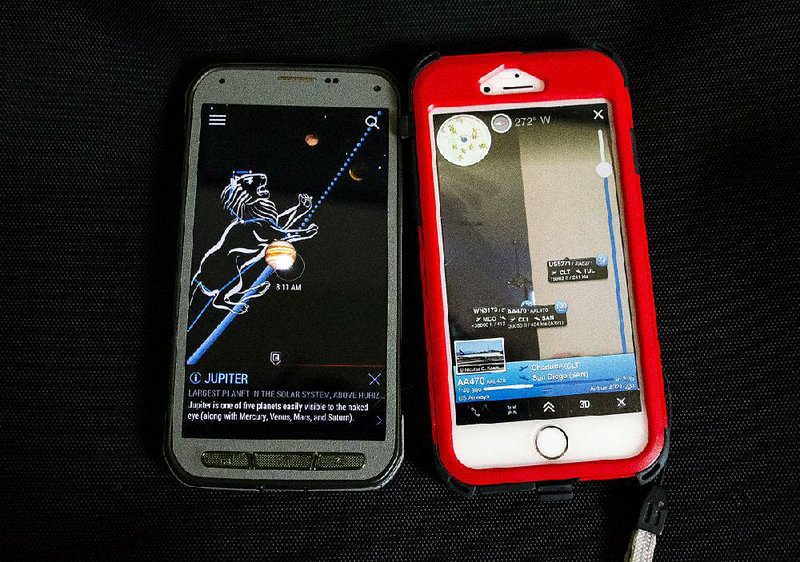Ever look up at the sky and wonder what's up there?
I happen to have a couple of apps that can answer that question, and in some very cool ways.
where it’s @
The SkyView Free app is available for free in the Apple App Store or Google Play store for Android phones. The paid version, which tracks more objects, is $1.99. FlightRadar24 also has a free version for Apple and Android phones. The paid version, which offers more flight information, is $3.99. More information on SkyView is available at terminaleleven.com. More information on FlightRadar24 is available at flightradar24.com.
The first app is made to help you discover what's out there beyond the Earth's atmosphere. It's called SkyView, and it's for space nerds and novices alike.
SkyView is available for iPhone and Android smartphones. It has a free and a paid version. The free version offers a lot of great features.
SkyView uses the phone's camera and inner compass to plot space objects, including stars, planets, moons and constellations. The on-camera mode will plot these heavenly bodies over what the camera sees, so you can match the constellation up with what you're actually seeing above you ... or what you're seeing in your living room. Turning the camera mode off displays a rich, lovely depiction of deep space.
Constellations pop up as the phone moves across their position. The app offers great information on the constellation, such as its origin, what it represents or in what season it's usually visible. The app does the same for other objects, such as the Hubble Space Telescope or the International Space Station . It states when planets are visible to the naked eye, and it even tracks the trajectory of planets, stars, satellites and the moon.
The app even includes a "night" mode that turns everything a deep red, which won't force your eyes to adjust to the light, allowing you to see better in the dark and observe more stars in space. It even allows you to choose dates to see celestial positions on that day. For example, you can see where the International Space Station will be visible flying over the Earth on Christmas or your birthday.
SkyView's free version offers a good glimpse of what the app has to offer. However, the paid version shows even more stars, constellations and "space junk," such as discarded rockets from past space missions like the Apollo program. It also shows deep-space star clusters, nebulae and distant galaxies and shows the information and trajectory of more satellites. The paid version is $1.99, which is pretty nominal for all this app shows.
The SkyView app is fun to use for anyone interested in space. For those wanting information on sky objects a little closer to Earth's surface, FlightRadar24 offers a similar setup for airplanes and gliders.
FlightRadar24 is available for iPhone and Android phones. It's available as a free version with limited features or a full version for $3.99.
Unfortunately, the free version doesn't offer much. The upgrade can be obtained with an in-app purchase for $3.99. It's worth it to get what you can from this app.
The free version offers the map view with few bells and whistles, and a live view with fewer extras. The map view shows the aircraft in the air and at landing or takeoff. Touching the plane can show the flight number and airline, but that's about it. All the good information is left to the paid version.
With the free version, users also miss out on handy features such as the filters that can limit the flights viewed by airline, altitude, aircraft type, speed and airport. You also can filter whether the aircraft is airborne or on the ground and even include or exclude gliders and ground vehicles. It also allows you to choose the data sources for the flight information and whether to allow the app to estimate plane positions should coverage be lost.
FlightRadar24's full version provides much more detail on the flight information. It provides real-time views of the altitude and speed, departure time and estimated landing time. It shows the flight path and even the plane's FAA registration number.
Then, it gets really fun.
The full version offers 3D view on iPhone and Cockpit View on the Android. Essentially, it shows a three-dimensional map of the terrain the plane is flying over at that time. It's interesting to see, and downright fun to watch on takeoffs and landings.
These details aren't just available in map mode. They're also available in the live view mode. Similar to that in SkyView, this mode is activated by touching the binoculars at the top of the screen. The phone's camera shows the space around the user, be it a room or the outdoors. Scanning around the area, small boxes pop up showing where flights are located in conjunction with the user.
Ever wonder where that plane humming overhead is headed? With the live view in FlightRadar24, you can point the phone to the plane and touch the box that pops up. The box shows the flight departure and destination airport codes, the height and the speed. Touching the box pops up the bottom panel with the same information as in the map view -- flight number and FAA designation, departure and estimated arrival time, type of plane, airline and its current altitude and speed.
FlightRadar24 is great for those who travel often or have friends or relatives who do. It makes it very easy to track flights. It's also great for those who just enjoy aviation.
It's amazing what's going on far above our heads. Thanks to these two apps, we can keep track of all of it.
Melissa L. Jones can be reached via email at mljones72@me.com.
SundayMonday Business on 08/31/2015
